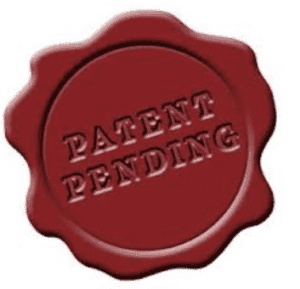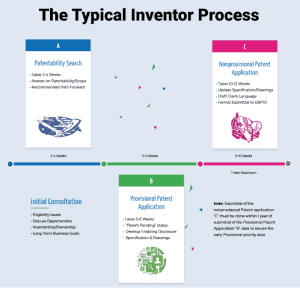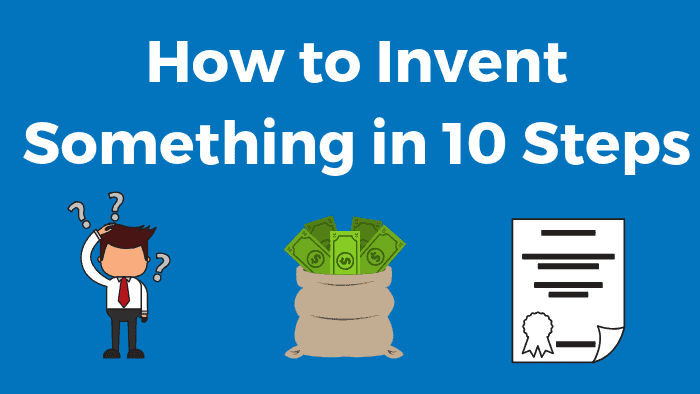What!? I’m going to tell you how to invent??? You bet. And while this may make some of you inventors a little heated to hear this…but in my honest opinion, ANYONE can be an inventor. Here’s how…
It’s so true that in life, difficult things to achieve are often the most highly valued. Inventing and patenting an invention are a couple of those difficult things in this world. So, while I say anyone can be an inventor – focus on the word can. I’m talking to the doers out there reading this, the people that get it done… my kinda people.

Inventing is a process, and by its very (legal) definition is going to be unique for every inventor. So, while this guide is intended for you to follow in a step-by-step format, it’s okay if you like some sections and not others. Use as much of it as you deem worthy; you’ll be better off for it.
I’ve outlined below the 10 steps I recommend you go through to put you in the best position possible for denting the universe and inspiring us all with your innovation:
Step 1: Believe in Yourself – Develop Confidence
I’m a HUGE Think & Grow Rich and Napoleon Hill fan. If you’ve never read it, I’ll give you permission to stop reading this blog and go read it/download it immediately!!!
One of my favorite lines from that book is “Whatever the mind can conceive and believe, the mind can achieve.”

Now… I’m not going to go on about positive mental attitude (although it has its virtues). The point here is that you’ve got to start this invention process with the right mindset that YOU CAN DO THIS!!! So, what should you do to start down this path?
Make sure to have a growth mindset. This means that while your invention idea may be one way to solve one problem…you’ve got to think big to really start getting excited at the potential of your solution.
Here are the ways in which you should push yourself to think outside of your initial invention concept:
- If it’s a tangible product, what other materials might your invention be made up of? Wood? Metal? Plastic? Composite?
- What types of structure/substrate could your invention operate in?
- If it’s an intangible process/method, how else could your invention perform the novel function? Could you store/gather/analyze/output information differently?
- How else might you apply your method to a completely new industry?
Take baby steps. And not just baby steps in any direction – but steps OUTSIDE YOUR COMFORT ZONE!

Being an inventor doesn’t mean you have to be an instant CEO of a business or be expected to be the next Mark Zuckerberg. That said, to have success, you will need to develop a business plan, learn to network, and get into some sales-like and marketing-type roles. These roles often make inventor-types who are more technical and introverted feel uncomfortable.
Just talking about your invention can be nerve-racking, I get it. I’m here to help you with that. What’s important is to continually expand your comfort zone as you innovate.
You’ll need to be willing to take some risks and learn from failures. The classic example is Thomas Edison’s famous 1000+ attempts at getting the right material for the lightbulb filament (turns out it was Tungsten). It’s a similar story for Michael Jordan and so, so many others.
Make like Edison and take a swing at solving the problem knowing full well that you might look dumb and that you’ll stumble. Just remember that failure will only get you if you give up… So don’t give up!
Step 2: Pay Attention – Write Down Problems or Struggles in Everyday Life
Alright!! You’ve now got the mindset for innovation, you’re inspired to grow, you have a positive mental attitude, and you’re not going to let failure stop you. Now what?
The truth is… you just have to LOOK AROUND! There’s potential for innovation EVERYWHERE. I suggest you start with your everyday routines, as they are the most memorable and easy.

Here’s a simple checklist of things to think of as you begin his journey (and don’t forget to get a digital or hard-copy journal to keep your notes in order. You’re going to have a LOT of them…):
- What annoys you? Is there anything that causes you pain, discomfort, or makes you scoff/shrug? Something you avoid because you know it’s going to lead to trouble?
- What would make your life easier? Could you combine technology solutions in a way that would make the one thing you do even better/more efficient?
- If you ever catch yourself saying “that’s just the way it is…” don’t accept that anymore. Don’t stop with just “OK” – find a way.
- Disgusted by repair prices for appliances or gadgets when they break? Notice how it’s almost always cheaper/less hassle to buy a new one? Don’t let that happen to you – take that uncomfortable step to try to fix your problems. Find new ways not just to save time/money but to make it BETTER than when you bought it new.
- If you ever think, “Oh, I don’t have the training or education to know how that works,” I call BS on that! If you are interested/passionate about a subject matter, the internet will teach you…and you can figure out a way!
Step 3: Map out Your Solution
That wasn’t so hard was it? Hopefully, you’ve got a good list of problems or you’ve identified some ways in which you could improve your life. GOOD JOB!
Now, you need to think through these solutions a bit more. Map them out.
Let’s say the problem you’ve identified is electric toothbrushes… you’re tired of the toothpaste getting stuck in the motorized gears and having to constantly clean it out.

Expand and bound the problem. Sure, in the morning, when you have caked on toothpaste and you have to clean it off when you’re groggy-eyed and don’t even want to brush in the first place, it’s fair to feel aggravated.
You need to think about ALL the places you dislike having toothpaste. It’s probably not just the detachable head area, but the handle, the bottom, and even deep inside the bristles, right? This is how you can start to expand the problem and fully define it in its greatest form.
Ok, so your solution (if possible) should try to address the LARGER (expanded and bounded) problem. Why not a case that covers the whole brush? Or a peelable film? You can brainstorm now that your mind is right. RIGHT? It’s fun.
Step 4: Evaluate Value vs. Effort in Solving Your Problems
Ok, so you’re now dealing with a bounded problem for which you’ve come up with one or more feasible solutions. Before you take your solution too much further, it’s going to be important to determine how much effort it’s going to take and to do a “scientific wild ass guess” (SWAG) as to what the market size/potential revenue would be for your solution.
Here’s an in-depth and amazingly scientific SWAG method I found online from a military example. It may provide some insight.
As you start to develop several invention ideas, review them and ask yourself how much value this will bring vs. how much effort it will cost. You want to focus on the inventions that take the least amount of effort with the highest value.

Go the extra mile and ask yourself the impact the project will have, the confidence you have in your ability to solve the problem, and the ease with which you believe you can solve this problem all on a 1-10 scale. Focus on the inventions that have the highest numbers!
Step 5: Do Basic Marketing Research (Is there a Product / Market fit?)
Do some basic research on the inventions you choose. Do you believe that the invention has a product-market fit? Why?

You’ve probably heard that phrase “product-market fit” floating around a bit. I found a very good article that has more on this topic here. The big takeaways are:
- Use one-on-one interviews to get to know your (potential) customers.
- Welcome feedback, but always weigh it based on customer value: keep an eye on where it comes from.
- Do not try to please everyone: be honest and open about your product road map.
Is this something that has already been patented? Jump on Google Patents to do a basic patent search on your own. You really should do your own searching before hiring a Patent Attorney to do a search to get all the basics you need to make sure the solution you’ve got is unique.
Step 6: Hire an Attorney to Perform a Patent Search & Give a Legal Opinion
Now it’s time to he a patent attorney to do a patent search to save you time and money by getting a professional legal opinion.
It’s that “Legal Opinion” part that is CRUCIAL. Most people miss that part and/or don’t appreciate it as much as they should.
The opinion will give you peace of mind on whether your invention is patentable and worth pursuing. If it is, you can push forward! If not, you are liberated to move on to the next idea!
I won’t drone on about legal services… I mean, it’s a little self-serving. I’ll let you read in-depth on our Patentability Search Opinion page instead!
Step 7: File a Provisional Patent Application
If the patent search comes in positive… move forward with a provisional patent to gain patent pending status and ensure your invention is safe. The United States is “first to file” not “first to invent,” so it’s important to get to this step ASAP.
One of the most exciting parts to actually learning how to write a patent application and then filing it is being able to say you are “Patent Pending”! This should be emblazoned on your products (if its a tangible invention) and certainly mentioned in any and all marketing materials. You have a major point of distinction – show it proudly.

Deciding whether to file a Provisional or Nonprovisional application is very situation-dependent, and your Bold Patent Attorney can help you decide.
Read our pages for Provisional Patent Application or Nonprovisional Patent Applications for even more in-depth information. You should also check out the difference between utility patents and design patents, should you also wish to file an application for either.

Step 8: Test Your Idea, Raise Money, Prove Proof of Concept
One major thing to mention is that when discussing your invention with a 3rd party, you should be careful to use a Nondisclosure Agreement (NDA) or Confidentiality Agreement.
This is because what you filed is not necessarily published, and you may disclose trade secrets or improvements of your invention that were not filed.
These slips could amount to an early disclosure barring you from getting protections for those improvements or, worse yet, a third party that takes the information and profits from it on their own (and you’ll have no recourse).
The testing that you do in this phase is critical! You have an entire YEAR from when you file a provisional to when the nonprovisional must be filed. Use that year to learn how your customers want to use your invention and make small modifications/tweaks to it to adjust for the demand.
Step 9: Launch Business or License/Sell
Now that you’ve filed at least a provisional patent application, you should have a very good idea whether you are planning to start and grow a business of your own or if you are looking to license or sell your invention to a third party who is already up and running (or plans to be).
Key things to think about as you make this decision:
- Are there big barriers to entry in the market (regulation, governmental red-tape, or large investment required) that would lead to wanting to license/sell to those that have already cleared those expensive hurdles?
- Are there infringers of your patent out there? Companies that may be unknowingly selling very similar products? They would be GREAT candidates to take a license or lump sum payment to be able to continue selling those products.
- Do you have big investors that are prepared to help form a team or supply chain and feel you’ve got enough of a head start with production to beat anyone else to market? This leans in favor of starting your own business!
Step 10: Patent & Portfolio Development
This starts with filing the Big Kahuna: the Nonprovisional Patent Application to ensure you are properly protected! You made it! You are living to your purpose and have protected and brought to market your visionary idea!
As the patent application proceeds through the United States Patent and Trademark Office (USPTO) and the assigned examiner, there will be opportunities for you to make a continuation or divisional filings to expand the scope of rights of your “parent” filing.
This is a great way to get the most out of your patent and make it more valuable to a potential licensee. Read all about strategies for developing a patent family through filing patent continuations/divisionals to see how you can make the most of your rights.
In Summary
No matter who you are, if you have the grit to stick with your idea to the end, you have the potential to be an inventor.
By following these steps, you will be on your way to becoming an inventor in no time:
- Believe in yourself
- Pay attention to problems
- Map out your solutions
- Evaluate value vs. effort
- Do basic marketing research
- Hire an attorney to perform a patent search
- File a provisional patent application
- Test your idea, raise money, provide proof of concept
- Launch your business or license/sell the patent
- Patent portfolio & development
Stop worrying about whether you have the qualifications or innate gift to invent! Look at your own needs in your life and work from there… what do you think could help improve the world?
Legal Note: This blog article does not constitute as legal advice. Although the article was written by a licensed USPTO patent attorney there are many factors and complexities that come into patenting an idea. We recommend you consult a lawyer if you want legal advice for your particular situation. No attorney-client or confidential relationship exists by simply reading and applying the steps stated in this blog article.

